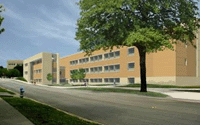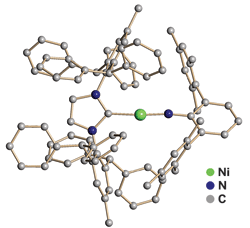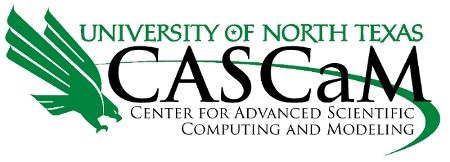CASCaM Instituted at UNT
[ Official UNT News Story ]
The University of North Texas is the home of the Center for
Advanced Scientific Computing and Modeling (CASCaM), whose
central mission involves research, education, training and outreach
in all facets of advanced scientific computing and modeling. The
CASCaM facility, supported by the United States
Department of Education, the United States
Department of Energy, and the United
States Air Force Research Laboratory, affords excellent
opportunities for collaboration with UNT computational chemists for
students and faculty mentors in Texas and the surrounding states.
You can download the official brochure here
(PDF format). A longer presentation of the CASCaM research,
resources, and faculty can be downloaded here (PDF
format).
New MMRC Position Open
The Materials Modeling Research Cluster (MMRC) at the University of North Texas invites applications for a senior (Assoc. or Full) faculty position in materials modeling.
New C3B Position Open
The Computational Chemical Biology Research Cluster (C3B) at the University of North Texas invites applications for a senior (Assoc. or Full) faculty position in computational chemical biology.
Yinka Olatunji-Ojo receives a Travel Award from the Division of Inorganic Chemistry of the ACS
Yinka Olatunji-Ojo, a graduate student conducting research with Dr. Thomas Cundari, has been awarded a Travel Award from the Division of Inorganic Chemistry of the American Chemical Society, to help with costs to the Fall 2011 ACS meeting.
Teen Finding Ways to Cut Energy Costs
Kurtis Carsch, a TAMS student working with Dr. Tom Cundari, had his research profiled on the NBC 5 news on March 28, 2011. You can read the article and see the news clip here:
http://www.nbcdfw.com/news/green/Teen-Finding-Ways-to-Cut-Energy-Costs-118807919.html
Rebecca Weber receives the 2011 NSF Graduate Research Fellowship
Rebecca Weber, a graduate student conducting research with Dr. Angela Wilson, has been awarded the 2011 NSF Graduate Research Fellowship. Rebecca is one of 2 UNT students to receive this national award.
One of the ten most-accessed articles from Organometallics in 2010: Palladium-Catalyzed C–H Activation/C–N Bond Formation Reactions: DFT Study of Reaction Mechanisms and Reactive Intermediates
An article by Zhuofeng Ke and Thomas R. Cundari is one of the ten most-accessed articles from Organometallics in 2010.
You can view the article here
C&E News: Two's A Charm For Nickel Complex
Dr. Cundari's paper, "A Two-Coordinate Nickel Imido Complex That Effects C−H Amination," is featured in an article by Chemical & Engineering News, titled: "Two's A Charm For Nickel Complex."
A quote from the article: “This piece of work illustrates a new way to effect the catalytic synthesis of organonitrogen compounds,” says Christopher C. Cummins of Massachusetts Institute of Technology, whose group focuses on using large ligands to make low-coordinate complexes. “The two-coordinate nickel imido catalyst itself represents a breakthrough in the chemistry of nickel,” Cummins adds, “and the simplicity of the transfer reaction system renders it amenable to a high degree of mechanistic analysis.”
Dr. Borden Recipient of 2011 ACS James Flack Norris Award
The American Chemical Society awarded Dr. Wes Borden the James Flack Norris Award for Outstanding Achievement in Physical Organic Chemistry. This award pays tribute to outstanding contributions to the field of physical organic chemistry.
Publication Chosen as Hot Paper: Catalytic C-H Amination with Unactivated Amines through Copper(II) Amides
Dr. Cundari recently published "Catalytic C-H Amination with Unactivated Amines through Copper(II) Amides" in "Angewandte Chemie International Edition." This paper was chosen as a Hot Paper, a paper chosen by the editors for its importance.
A quote from the abstract:
Two equivalents of the three-coordinate copper(II) amide [(Cl2NN)Cu]-NHAd participate in stoichiometric C H amination by a H-atom abstraction/radical capture sequence. This active species may be generated through a copper(II) tert-butoxide intermediate to allow for the unprecedented catalytic amination of sp3-C
H amination by a H-atom abstraction/radical capture sequence. This active species may be generated through a copper(II) tert-butoxide intermediate to allow for the unprecedented catalytic amination of sp3-C H bonds with unactivated alkylamines. This method greatly expands the range of amines for catalytic C
H bonds with unactivated alkylamines. This method greatly expands the range of amines for catalytic C H amination since most protocols require N-based electron-withdrawing groups.
H amination since most protocols require N-based electron-withdrawing groups.
You can view the article here.
New Publication: Towards More Relaxed Conditions for a Gamma-ray Laser:
Methods to Realize Induced Transparency for Nuclear Resonant Gamma Radiation
Dr. Rostovtsev recently published "Towards more relaxed conditions for a gamma-ray laser: Methods to realize induced transparency for nuclear resonant gamma radiation" in "Laser & Photonics Review"
A quote from the abstract:
The ability to determine the structure of matter in three dimensions has profoundly advanced our understanding of nature. Traditionally, the most widely used schemes for three-dimensional (3D) structure determination of an object are implemented by acquiring multiple measurements over various sample orientations, as in the case of crystallography and tomography1, 2, or by scanning a series of thin sections through the sample, as in confocal microscopy3. Here we present a 3D imaging modality, termed ankylography (derived from the Greek words ankylos meaning ‘curved’ and graphein meaning ‘writing’), which under certain circumstances enables complete 3D structure determination from a single exposure using a monochromatic incident beam.
You can view the pdf. here.
New Publication: Three-Dimensional Structure Determination from a Single View
Dr. Du recently published "Three-dimensional Structure Determination from a Single View" in the "Nature, International Weekly Journal of Science."
A quote from the abstract:
We suggest and demonstrate that the proper use of these “bright” and “dark” exciton states with distinctively different recombination times may turn the situation around: the use of quantum coherence and multiphoton schemes of excitation potentially not only allow one to efficiently manipulate the dark states, but can also create conditions for efficient light generation in different frequency regions, produce “slow” or “fast” light, implement quantum light storage, and media with a negative refractive index.
New Publication: "Dark and "Bright" Excitons in Carbon Nanotubes:
New Media for Quantum Optics
Dr. Rostovtsev recently published "'Dark' and 'Bright' Excitons in Carbon Nanotubes: New Media for Quantum Optics" in the "Journal of Nanoelectronics and Optoelectronics."
A quote from the abstract:
We suggest and demonstrate that the proper use of these “bright” and “dark” exciton states with distinctively different recombination times may turn the situation around: the use of quantum coherence and multiphoton schemes of excitation potentially not only allow one to efficiently manipulate the dark states, but can also create conditions for efficient light generation in different frequency regions, produce “slow” or “fast” light, implement quantum light storage, and media with a negative refractive index.
Dr. Wes Borden, University Distinguished Research Professor
At this year's Spring Faculty Meeting: Faculty Awards Ceremony, the Provost announced that Wes Borden had received the special recognition of University Distinguished Research Professor. Dr. Borden is one of only two faculty members in the entire University to be named a University Distinguished Research Professor.
CASCaM Spotlight in Latest Volume of UNT Research
The 2010 edition of the UNT Deapartment for Research and Economic Development's magazine, titled
UNT Research , focused on the collaborative work of CASCaM and highlighted many of our members.
- Studying Aircraft Fatigue: The collaborative efforts of CASCaM and the Center for Advanced Research and Technology (CART).
- Awards: Dr. Srvilliputhur is mentioned for his NSF CAREER Award and Dr. Borden is mentioned for his award as an inaugural fellow of the American Chemical Society.
- News Briefs: Dr. Wilson is mentioned for her Teacher Scholar Award and Dr. Du is mentioned for his research on bioactive glass.
- Faculty Researchers: Dr. Zhiqiang is featured for his research as a computational materials scientist.
CASCaM Researchers Intel Science Talent Search Semifinalists
This year, CASCaM had three Texas Acadamy of Math and Science (TAMS) students reach semifinalist stage in the Intel Science Talent Search. Out of almost 2,000 applicants, only 300 semifinalists were chosen.
- Somak Das with his paper: The ONIOM Correlation Consistent Composite Approach for Systems of Biological Importance
- Smitha Janardan with her paper: Computational Study on NiA1: Ground State, Structure, and Spectroscopic Constants Using Density Functional Theory
- Katheryn Shi with her paper: Quantum Mechanical Prediction of the Existence of Rare Gas-bound Species
New Publication: Computational Study of Methane C-H Activation by First-Row Late Transition Metal LnM=E (M: Fe, Co, Ni) Complexes
Aaron Pierpont and Dr. Tom Cundari recently published their Computational Study of Methane C-H Activation by First-Row Late Transition Metal LnM=E (M: Fe, Co, Ni) Complexes in the ACS journal: Inorganic Chemistry. The article is featured as the cover article for the journal.
A quote from the abstract:
Methane functionalization via LnM═E active species (Ln = β-diketiminate, dihydrophosphinoethane; M = Fe−Ni, E = NCF3, NCH3, O) through a hydrogen atom abstraction (HAA)/radical rebound (RR) mechanism is calculated to be thermodynamically and kinetically feasible. The enthalpies of each reaction decrease in the order Fe > Co > Ni and with the proximity of CF3 supporting ligand substituents (“fluorination”) to the metal center.
You can find the article here.
Or view the pdf here.
Dr. Mike Drummond featured in the New York Times
Dr. Michael Drummond's latest article, "Toward Greener Carbon Capture Technologies: A Pharmacophore-Based Approach to Predict CO2 Binding Sites in Proteins," is featured in the ClimateWire section of the New York Times. Check it out at nytimes.com.
"Toward Greener Carbon Capture Technologies: A Pharmacophore-Based Approach to Predict CO2 Binding Sites in Proteins"
by Drs. Drummond, Wilson, and Cundari
Dr. Michael Drummond, along with Drs. Angela Wilson and Thomas Cundari, published a new article on December 30, 2009 titled: Toward Greener Carbon Capture Technologies: A Pharmacophore-Based Approach to Predict CO2 Binding Sites in Proteins". This publication is featured in the ACS News Service Weekly PressPac: February 03, 2010, which states: "Carbon dioxide from industrial smokestacks could be captured with eco-friendly proteins developed with a technique long used to discover new medicines."
A quote from the abstract:
"Successful sequestration of emitted carbon dioxide is a crucial ingredient in addressing rising atmospheric CO2 concentrations, but current CO2 capture technologies are often corrosive and can generate hazardous waste. Inspiration for more environmentally friendly sequestration is sought in Nature by searching for common patterns by which proteins bind CO2. Specifically, three-dimensional functional group patterns responsible for binding CO2 are extracted from the few protein-CO2 complexes that have been characterized by X-ray Crystallography."
You can find the article here.
View the ACS write up here.
Dr. Wilson on Editorial Board of JPC
Dr. Angela Wilson has been named to the Editorial Advisory Board of the Journal of Physical Chemistry (JPC). JPC is the top journal within the subdiscipline of phsyical chemistry, which includes computational chemistry. Her term will begin in January 2010.
CASCaM Faculty Available for Seminars
The CASCaM Faculty are available to give seminars on topics related to their field. You can find a list here of interesting faculty topics or contact the professor directly.
List of Professors and Seminar Topics
CASCaM and MMRC Researchers to Work With Energy Frontier Research Center
CASCaM and MMRC researchers, Profs. Tom Cundari, Jincheng Du and Srinivasan Srivilliputhur, will participate in one of the 46 funded Energy Frontier Research Centers (EFRCs). The project is lead by long-time Cundari Group collaborator, Prof. T. Brent Gunnoe (Chemistry, U. Va.). UNT team will work with leading researchers from Virginia, Yale, Princeton, CalTech, UNC-Chapel Hill, and several others to identify novel catalysts for meeting the U.S.'s energy needs. The UNT team along with groups at U. of Maryland and CalTech will provide the lead in modeling and simulation research within this EFRC, entitled "Center for Catalytic Hydrocarbon Functionalization."

